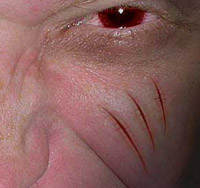Warts, papillomas and scars should be removed in fall
Scars are good for men only while warts are good for no one. Therefore, the latter should be promptly eradicated.

“A patient who wants to have his mole removed should always visit a dermatologist or dermatological oncologist first.”
A cosmetic dermatologist is a medical professional specialized in the removal of scars, moles and warts. A cosmetic dermatologist must be trained in a medical school of university level, with a major in dermatology and cosmetic dermatology. A well-known cosmetic surgery establishment or a beauty parlor of good repute will be the best place to seek help in case of skin blemishes.
By the bye, fall is the best time of the year for performing cosmetic surgery of the above kind. There is a higher risk of infection for the skin following surgery performed in a hot summer. The immune system is weaker in winter and spring, and therefore the healing process takes longer to complete.
The scars left by operations and injuries are the most difficult in terms of removal. In fact, such scars cannot be removed completely, they can only be made less noticeable. The so-called W-plastic surgery and Z-plastic surgery methods are used in case a scar is very large. The scar is excised and covered with patches of neighboring tissues. Eventually, the scar is reduced to a thin zigzag line on the skin.
Flat scars are particularly noticeable due to skin discoloration. They can be disguised by inserting flesh-colored pigments into a scar.
Keloid formation is an overgrowth of fibrous scar tissue following trauma to the skin. It does not resolve spontaneously but can be flattened by applying pressure or with injections of potent corticosteroids. Keloid formation is particularly common in dark-complexioned persons – even a small scratch on the skin can result in a keloid scar. Apart from regular surgery, radiotherapy is also used for treatment of the above.
Polishing small-sized scars by a laser beam or a mechanical tool can bring good results. Yet the method is quite costly, and therefore is mostly used for improving beauty of the face. Laser equipment is used for 45-60 minutes to a patient under general anesthesia. A local anesthetic is administered during the use of a mechanical cutter (occasionally in combination with a cautery) for 10-20 minutes. However, a patient will have to wait for about a week until a swelling on his face disappears. The skin will take another six months to get back to its normal look.
Dermatologists often have to treat the so-called trophic or superficial scars left by acne or chickenpox. The scars are normally removed by chemical peeling of the skin. Special acids are used for the purpose. The hypertrophic scars run deeper in the skin, and therefore are more difficult to remove. In some cases skin transplantation is required. A scar tissue is replaced with skin graft or a piece of skin that is cut from a healthy part of the body.
Removing moles or melanotic nevuses is a more difficult task. A patient who wants to have his mole removed should always visit his dermatologist or dermatological oncologist first. A histological examination of removed tissues is highly recommended because some moles (especially the new ones or those who are irregular in shape or change their shape, color etc.) may be an early sign of malignant melanoma.
Moles can be removed by using several methods: electrocoagulation, laser surgery, cryosurgery, and common surgery.
Electrocoagulation is the use of a high-frequency electric current for the destruction of unwanted tissues. The scars left by the procedure are small and well-shaped.
Laser surgery is the use of a laser beam for clotting tiny blood vessels. The method permits virtually bloodless surgery to be performed. Such an operation speeds up the pace of skin regeneration, and its cosmetic effects are fairly high. However, a laser beam can be used only for treating nonmalignant moles. The removed tissues cannot be examined in this case.
Common surgery is one of the most widely used methods for removing moles, especially the flat ones. However, the procedure requires surgical excision of some skin around the mole, not to mention the excision of the mole itself. A patient has to deal with a new scar once the stitches are cut and removed.
Cryosurgery is the use of extreme cold in a localized part of the body to freeze and destroy unwanted tissues. The method is not perfect for removing moles. It is difficult to control the dispersion of cold through the tissues. As a result, the skin adjoining the mole may be subject to an accidental trauma. In any case, a medically qualified doctor must choose the right method of treatment.
Papillomas are easier to deal with. The methods used for removing moles can be used for destroying papillomas. Each method has its own pros and cons. For example, the formation of a scar cannot be avoided during surgery. On the other hand, it is not always possible to control action on the tissues in terms of a desired depth when using a cryoprobe or laser beam. Therefore, several methods are sometimes combined for performing a certain procedure.
Medportal
Translated by Guerman Grachev
Pravda.ru
Subscribe to Pravda.Ru Telegram channel, Facebook, RSS!


